Information Entropy in Predicting Location of Observation Points for Long Tunnel
Abstract
:1. Introduction
2. Methodology
2.1. Probabilistic Estimation of Geologic Parameters along the Tunnel
2.2. Location Optimization of Geological Investigation Points
3. Case Study
4. Discussion
5. Conclusions
Acknowledgments
Author Contributions
Conflicts of interest
References
- Xuan, T.; Li, J.H.; Li, D.Q.; Song, L. Optimization of locations of site investigation using ordinary Kriging method. Eng. J. Wuhan Univ. 2016, 21, 714–719. [Google Scholar]
- Felletti, F.; Beretta, G.P. Expectation of boulder frequency when tunneling in glacial till: A statistical approach based on transition probability. Eng. Geol. 2009, 108, 43–53. [Google Scholar] [CrossRef]
- Ioannou, P.G. Geologic Prediction Model for Tunneling. J. Constr. Eng. Manag. 1987, 113, 569–590. [Google Scholar] [CrossRef]
- Ioannou, P.G. Dynamic Probabilistic Decision Processes. J. Constr. Eng. Manag. 1989, 115, 237–257. [Google Scholar] [CrossRef]
- Ioannou, P.G. UM-CYCLONE Discrete Event Simulation System User’s Guide. Available online: http://cem.umich.edu/Ioannou/CYCLONE/userguid.pdf (accessed on 29 June 2017).
- Ching, J.; Chen, Y.C. Transitional Markov Chain Monte Carlo Method for Bayesian Model Updating, Model Class Selection, and Model Averaging. J. Eng. Mech. 2007, 133, 816–832. [Google Scholar] [CrossRef]
- Miranda, T.; Correia, A.G.; Sousa, L.R.E. Bayesian methodology for updating geomechanical parameters and uncertainty quantification. Int. J. Rock Mech. Min. Sci. 2009, 46, 1144–1153. [Google Scholar] [CrossRef]
- Alagoz, O.; Hsu, H.; Schaefer, A.J.; Roberts, M.S. Markov Decision Processes: A Tool for Sequential Decision Making under Uncertainty. Med. Decis. Mak. 2010, 30, 474–483. [Google Scholar] [CrossRef] [PubMed]
- Baasch, A.; Tischew, S.; Bruelheide, H. Twelve years of succession on sandy substrates in a post-mining landscape: A Markov chain analysis. Ecol. Appl. A Publ. Ecol. Soc. Am. 2010, 20, 1136–1147. [Google Scholar] [CrossRef]
- Farahat, A. Markov stochastic technique to determine galactic cosmic ray sources distribution. J. Astrophys. Astron. 2010, 31, 81–88. [Google Scholar] [CrossRef]
- Liu, L.M.; Tong, C.N.; Wu, Y.K. Markovian jump model for networked control systems with dynamic output feedback controllers. Acta Autom. Sin. 2009, 35, 627–631. [Google Scholar]
- Liu, Z.F.; Hao, T.Y.; Fang, H. Modeling of stochastic reservoir lithofacies with Markov chain model. Acta Pet. Sin. 2005, 26, 57–60. [Google Scholar]
- Liu, D.; Xuan, P.; Li, S.; Huang, P. Schedule Risk Analysis for TBM Tunneling Based on Adaptive CYCLONE Simulation in a Geologic Uncertainty–Aware Context. J. Comput. Civ. Eng. 2015, 29, 04014103. [Google Scholar] [CrossRef]
- Liu, D.H.; Zhou, Y.Q.; Wang, S.; Zhang, Y.L. Stochastic Simulation and Risk Analysis of Water Tunnel TBM Construction Scheduling Based on Geologic Prediction Using Markov Process. J. Syst. Simul. 2009, 21, 558–562. [Google Scholar]
- Shannon, C.E. A mathmatical theory of communication. Bell Syst. Tech. J. 1948, 27, 379–423. [Google Scholar] [CrossRef]
- Jaynes, E.T. Information Theory and Statistical Mechanics. Phys. Rev. 1957, 106, 620–630. [Google Scholar] [CrossRef]
- Nemzer, L.R. Shannon information entropy in the canonical genetic code. J. Theor. Biol. 2016, 415, 158–170. [Google Scholar] [CrossRef] [PubMed]
- Chen, N.; Liu, Y.; Chen, H.; Cheng, J. Detecting communities in social networks using label propagation with information entropy. Phys. A Stat. Mech. Appl. 2017, 471, 788–798. [Google Scholar] [CrossRef]
- Jing, Y.; Wang, S.C.; Yuan, Q.Y. Application of Markov process in geology. Beijing Geol Publ. House 1986, 21, 5–115. [Google Scholar]
- Haas, C.; Einstein, H.H. Updating the Decision Aids for Tunneling. J. Constr. Eng. Manag. 2002, 128, 40–48. [Google Scholar] [CrossRef]
- Garg, H. An Approach for Analyzing the Reliability of Industrial System Using Fuzzy Kolmogorov’s Differential Equations. Arab. J. Sci. Eng. 2015, 40, 975–987. [Google Scholar] [CrossRef]
- Kolmogoroff, A. Über die analytischen Methoden in der Wahrscheinlichkeitsrechnung. Math. Ann. 1931, 104, 415–458. (In German) [Google Scholar] [CrossRef]
- Technical Code for Building Pile Foundations. Available online: http://morgain.com/Help/JGJ94-2008/JGJ94-2008.htm (accessed on 29 June 2017). (In Chinese).
- Špačková, O.; Straub, D. Dynamic Bayesian Network for Probabilistic Modeling of Tunnel Excavation Processes. Comput. Aided Civ. Infrastruct. Eng. 2013, 28, 1–21. [Google Scholar] [CrossRef]
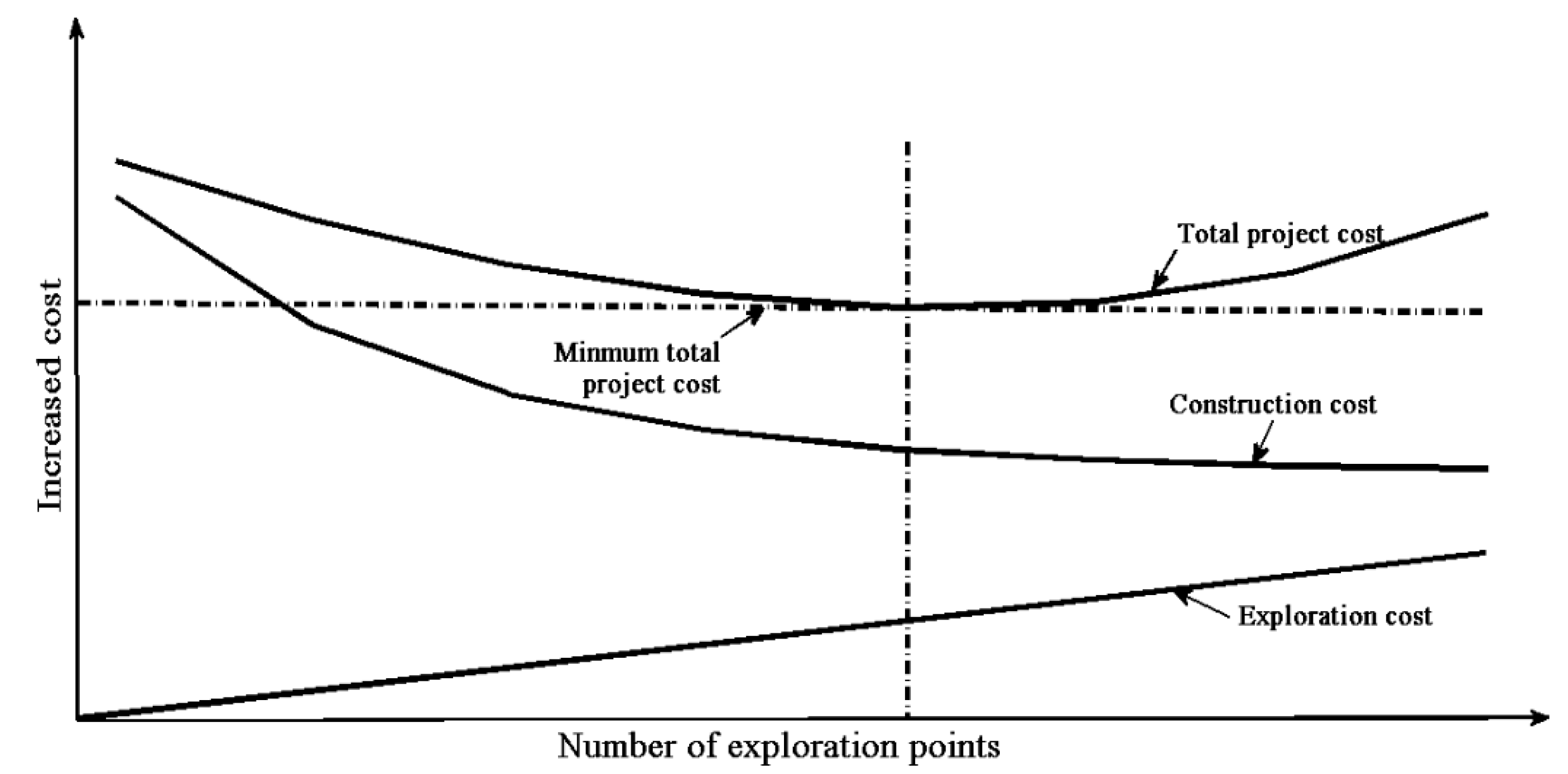

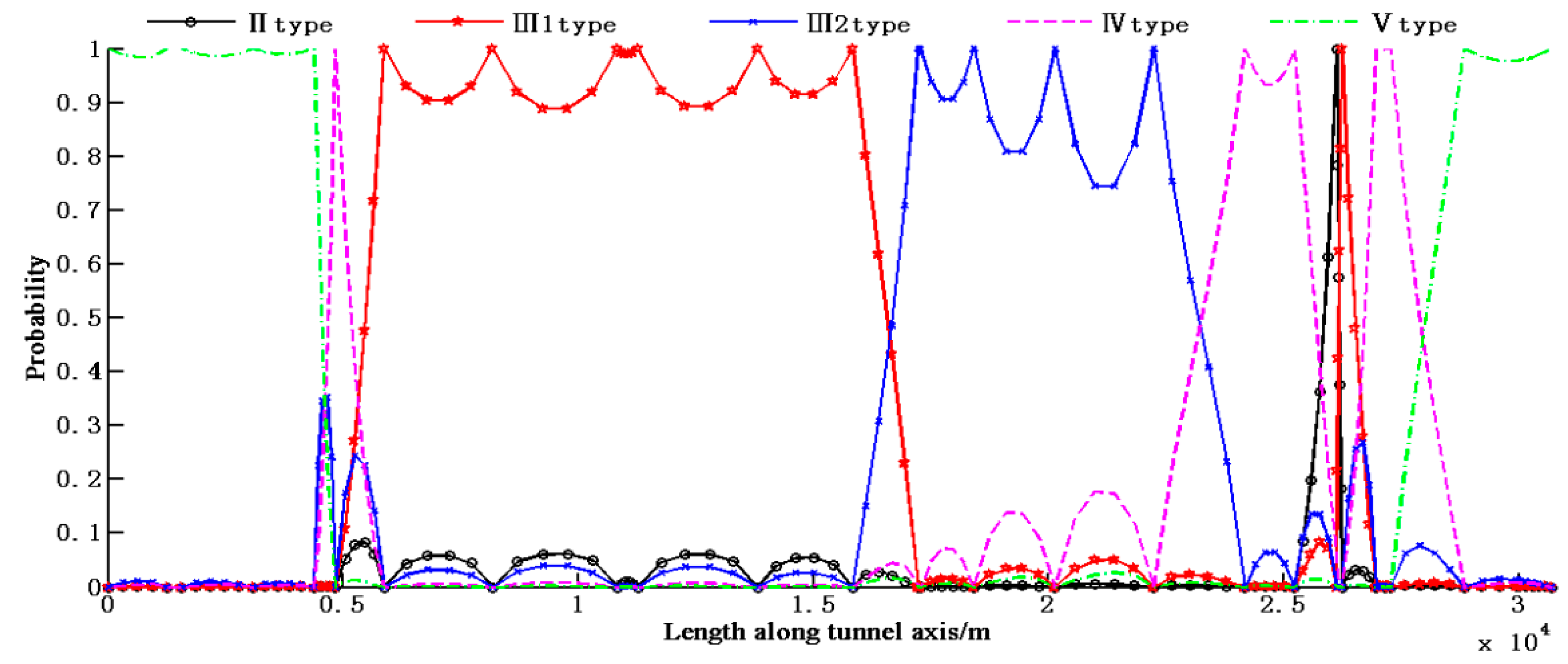
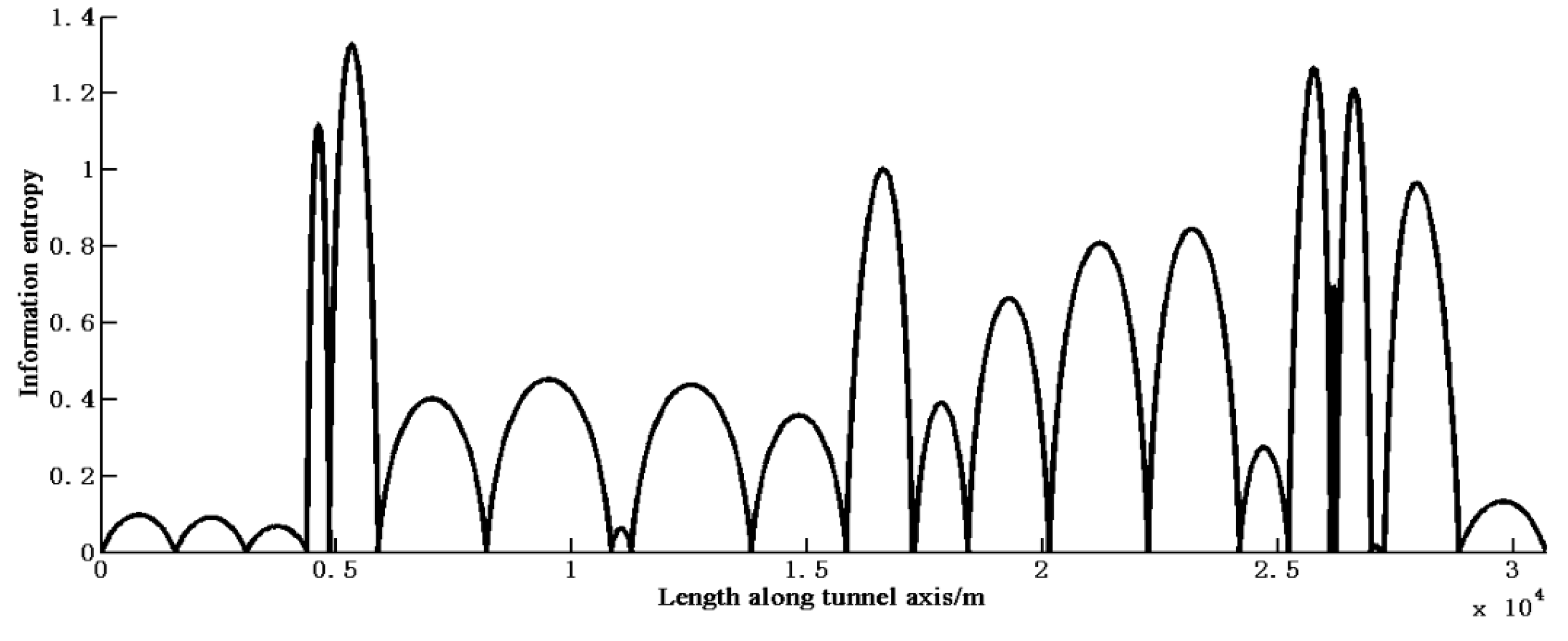
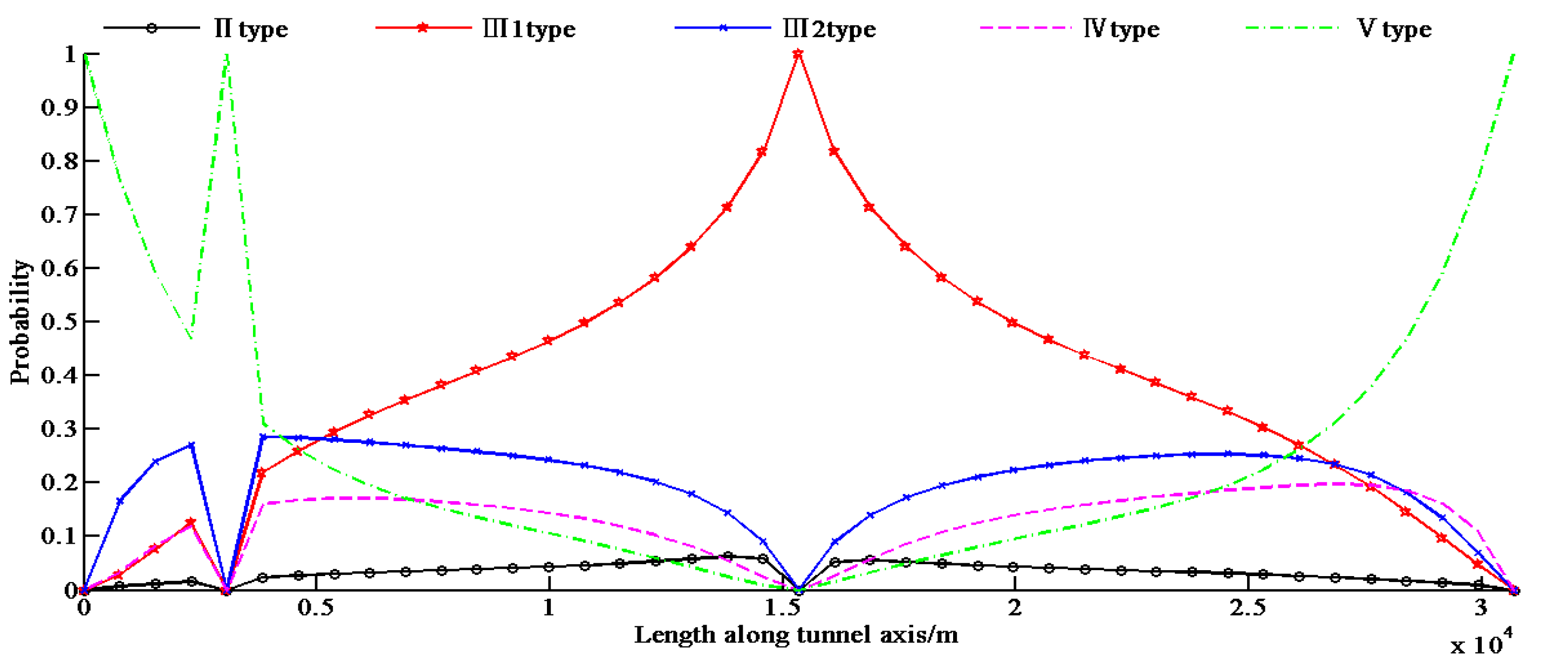
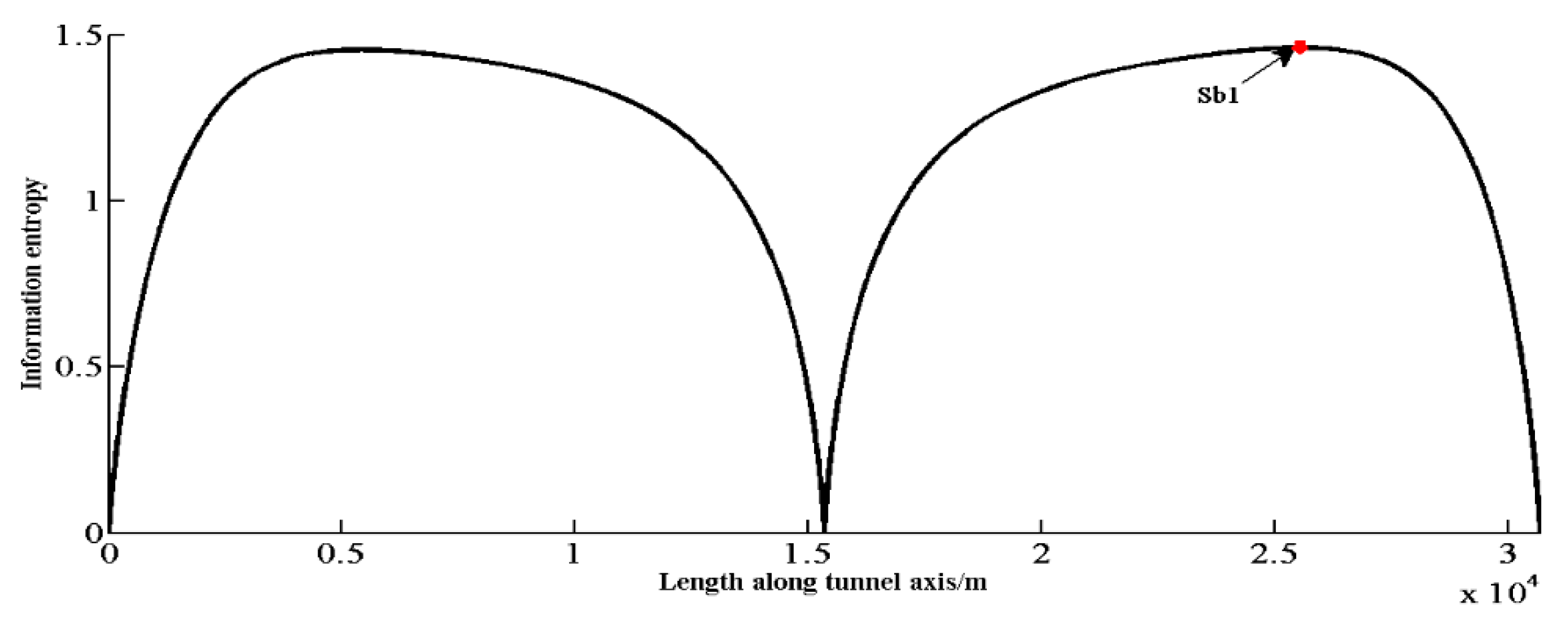
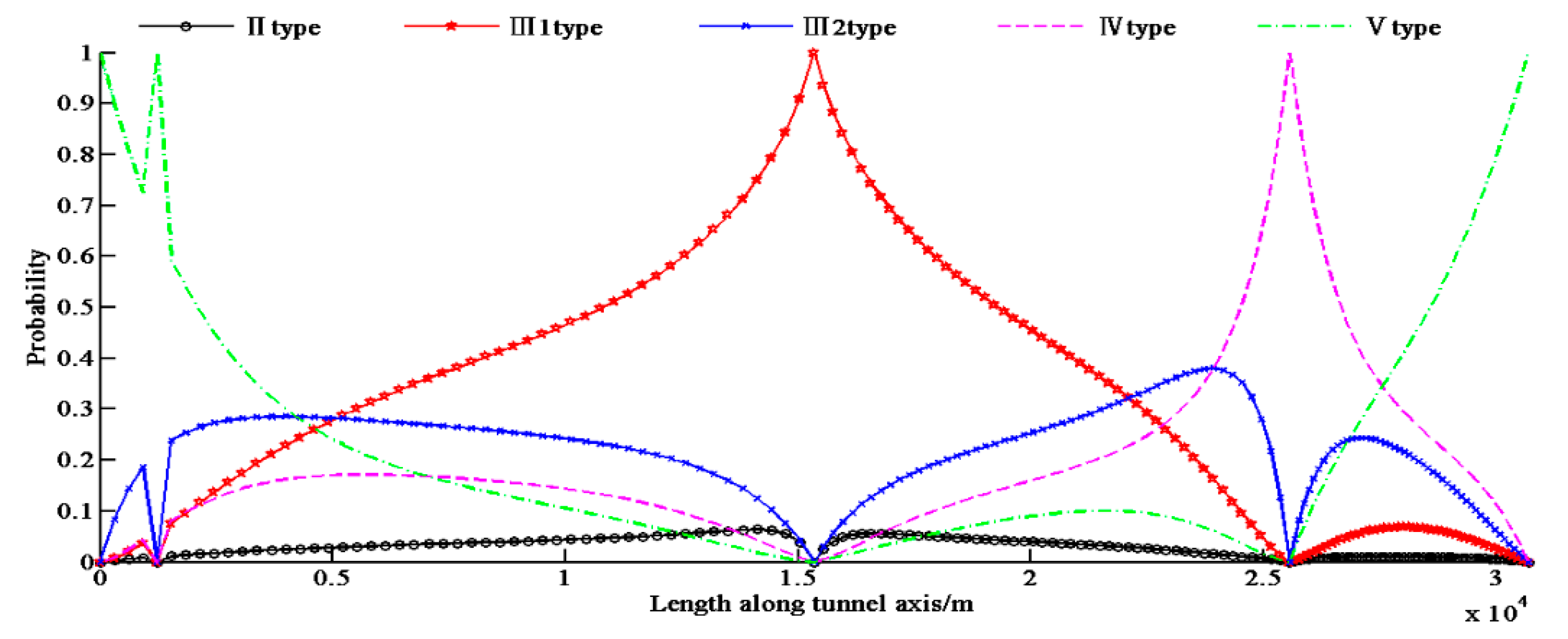

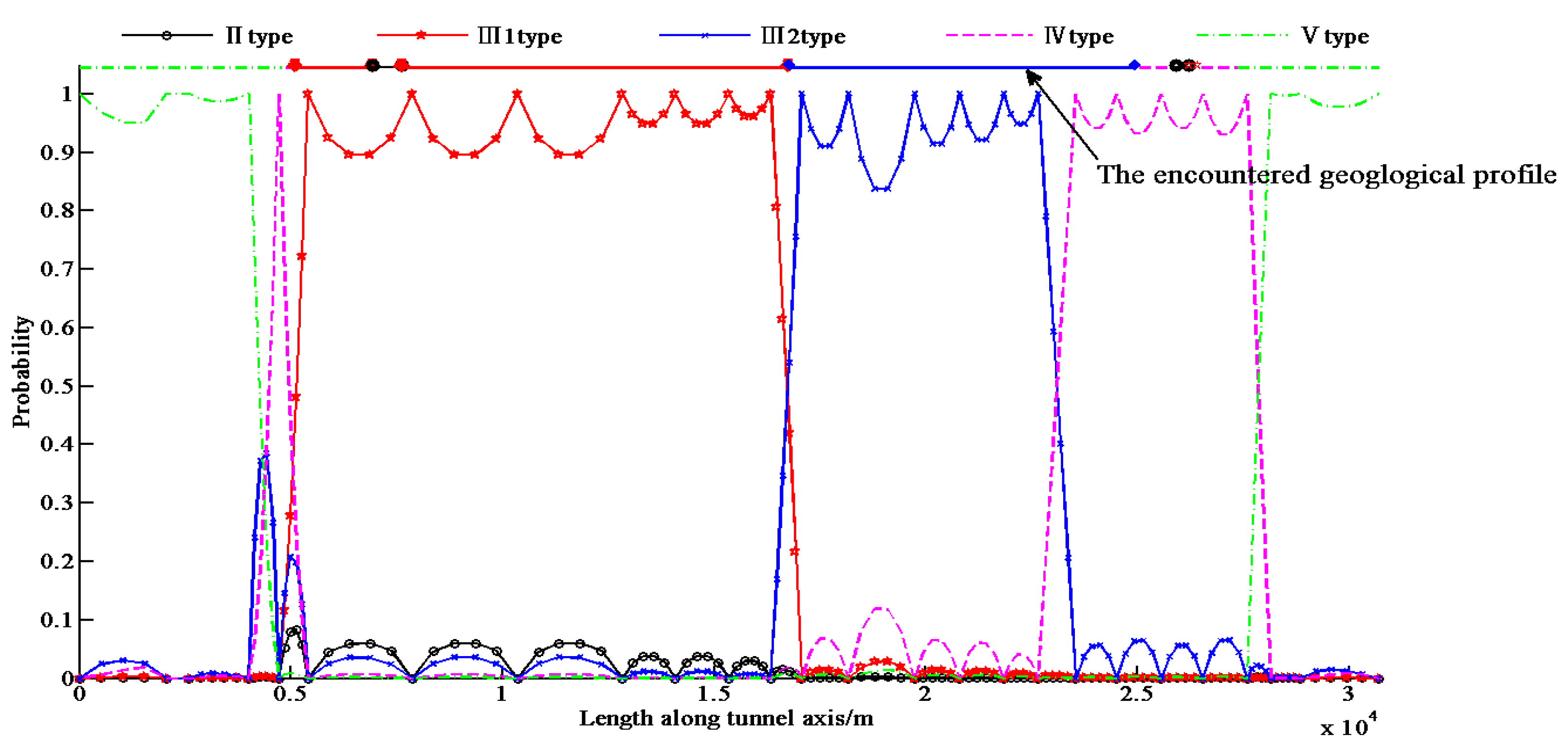
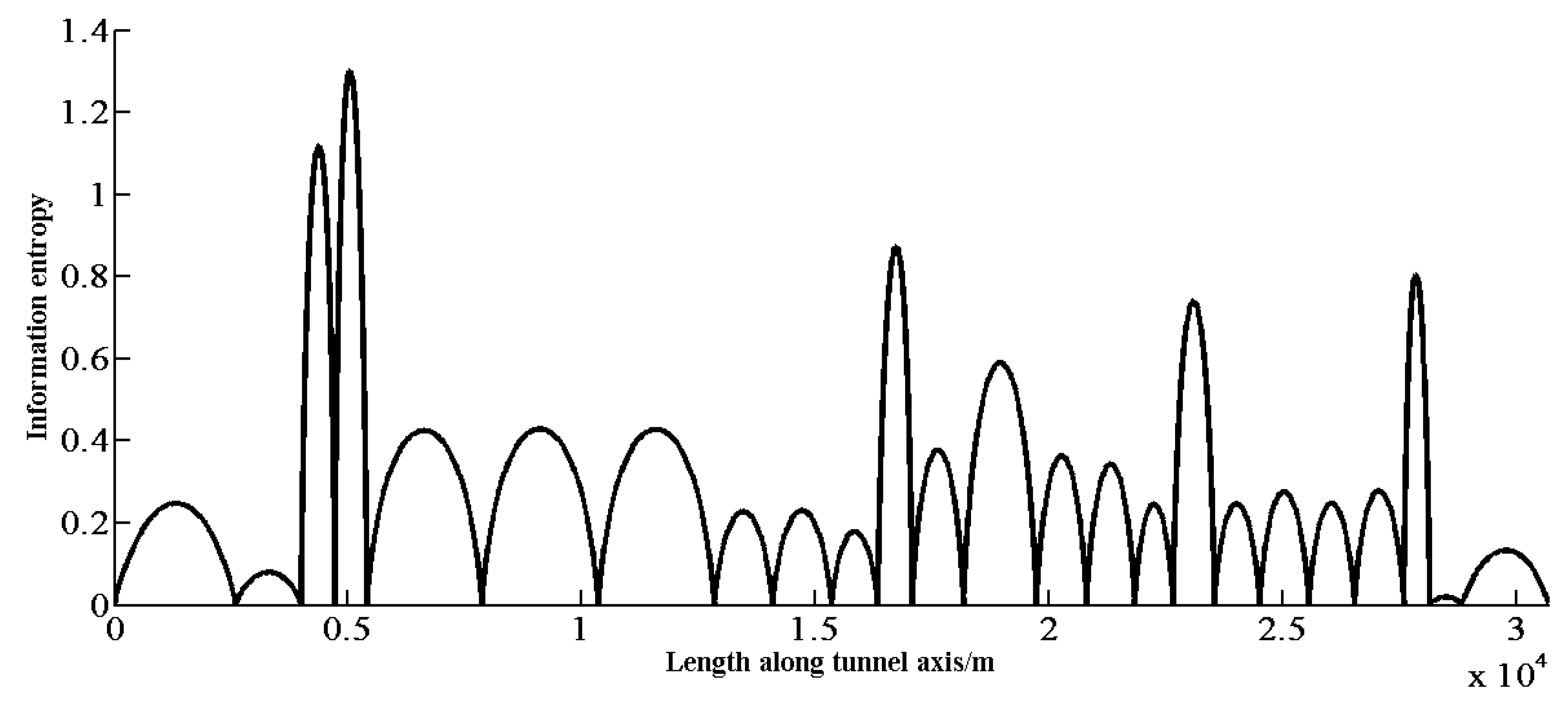

| Location (along the Tunnel; m) | Surrounding Rock | Location (along the Tunnel; m) | Surrounding Rock |
|---|---|---|---|
| 0 (starting point) | V type | 18,416 | III2 type |
| 1570 | V type | 20,144 | III2 type |
| 3080 | V type | 22,242 | III2 type |
| 4380 | V type | 24,187 | IV type |
| 4841 | IV type | 25,234 | IV type |
| 5880 | III1 type | 26,126 | II type |
| 8185 | III1 type | 26,239 | III1 type |
| 10,836 | III1 type | 26,974 | IV type |
| 11,264 | III1 type | 27,165 | IV type |
| 13,815 | III1 type | 27,274 | IV type |
| 15,832 | III1 type | 28,847 | V type |
| 17,230 | III2 type | 30,691 (end point) | V type |
| 17,284 | III2 type | - | - |
| Additional Quantities | Total Quantities | Optimal Location (along the Tunnel; m) | Surrounding Rock | Total Information Entropy |
|---|---|---|---|---|
| 1 | 3 | - | - | 37,129 |
| 2 | 4 | 25,566 | IV type | 35,172 |
| 3 | 5 | 5398 | III1 type | 31,665 |
| 4 | 6 | 21,837 | III2 type | 30,123 |
| 5 | 7 | 10,353 | III1 type | 26,647 |
| 6 | 8 | 19,732 | III2 type | 25,284 |
| 7 | 9 | 2580 | V type | 22,825 |
| 8 | 10 | 27,601 | IV type | 21,283 |
| 9 | 11 | 18,173 | III2 type | 20,137 |
| 10 | 12 | 23,540 | IV type | 18,943 |
| 11 | 13 | 12,836 | III1 type | 17,641 |
| 12 | 14 | 7862 | III1 type | 16,356 |
| 13 | 15 | 3999 | V type | 14,597 |
| 14 | 16 | 28,843 | V type | 13,357 |
| 15 | 17 | 17,070 | III2 type | 12,501 |
| 16 | 18 | 4711 | IV type | 12,381 |
| 17 | 19 | 16,339 | III1 type | 11,647 |
| 18 | 20 | 20,806 | III2 type | 10,906 |
| 19 | 21 | 22,661 | III2 type | 10,490 |
| 20 | 22 | 26,543 | IV type | 9928.6 |
| 21 | 23 | 24,513 | IV type | 9371.9 |
| 22 | 24 | 28,148 | V type | 8879.9 |
| 23 | 25 | 14,085 | III1 type | 8489 |
© 2017 by the authors. Licensee MDPI, Basel, Switzerland. This article is an open access article distributed under the terms and conditions of the Creative Commons Attribution (CC BY) license (http://creativecommons.org/licenses/by/4.0/).
Share and Cite
Xu, C.; Hu, C.; Liu, X.; Wang, S. Information Entropy in Predicting Location of Observation Points for Long Tunnel. Entropy 2017, 19, 332. https://doi.org/10.3390/e19070332
Xu C, Hu C, Liu X, Wang S. Information Entropy in Predicting Location of Observation Points for Long Tunnel. Entropy. 2017; 19(7):332. https://doi.org/10.3390/e19070332
Chicago/Turabian StyleXu, Chen, Chengke Hu, Xiaoli Liu, and Sijing Wang. 2017. "Information Entropy in Predicting Location of Observation Points for Long Tunnel" Entropy 19, no. 7: 332. https://doi.org/10.3390/e19070332




